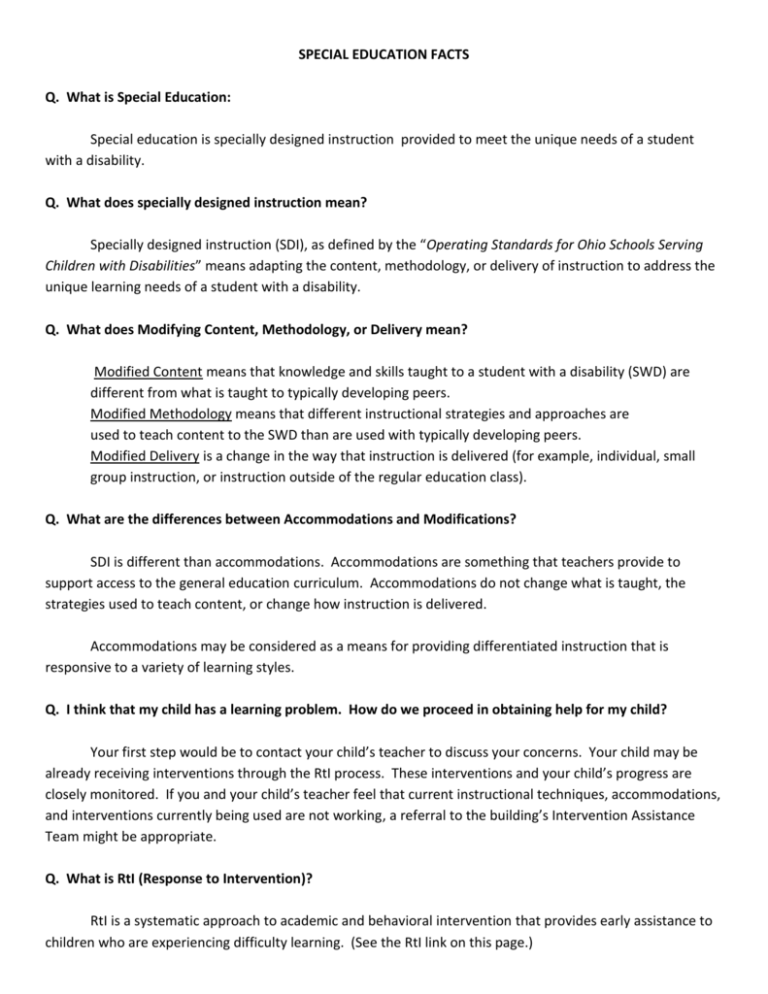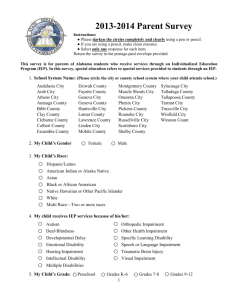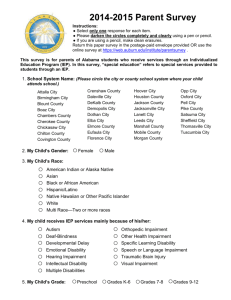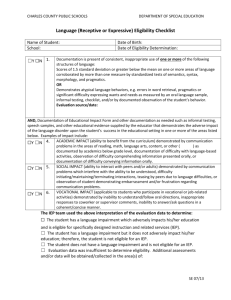Special Education Q & A - Marlington Local Schools
advertisement

SPECIAL EDUCATION FACTS Q. What is Special Education: Special education is specially designed instruction provided to meet the unique needs of a student with a disability. Q. What does specially designed instruction mean? Specially designed instruction (SDI), as defined by the “Operating Standards for Ohio Schools Serving Children with Disabilities” means adapting the content, methodology, or delivery of instruction to address the unique learning needs of a student with a disability. Q. What does Modifying Content, Methodology, or Delivery mean? Modified Content means that knowledge and skills taught to a student with a disability (SWD) are different from what is taught to typically developing peers. Modified Methodology means that different instructional strategies and approaches are used to teach content to the SWD than are used with typically developing peers. Modified Delivery is a change in the way that instruction is delivered (for example, individual, small group instruction, or instruction outside of the regular education class). Q. What are the differences between Accommodations and Modifications? SDI is different than accommodations. Accommodations are something that teachers provide to support access to the general education curriculum. Accommodations do not change what is taught, the strategies used to teach content, or change how instruction is delivered. Accommodations may be considered as a means for providing differentiated instruction that is responsive to a variety of learning styles. Q. I think that my child has a learning problem. How do we proceed in obtaining help for my child? Your first step would be to contact your child’s teacher to discuss your concerns. Your child may be already receiving interventions through the RtI process. These interventions and your child’s progress are closely monitored. If you and your child’s teacher feel that current instructional techniques, accommodations, and interventions currently being used are not working, a referral to the building’s Intervention Assistance Team might be appropriate. Q. What is RtI (Response to Intervention)? RtI is a systematic approach to academic and behavioral intervention that provides early assistance to children who are experiencing difficulty learning. (See the RtI link on this page.) Q. What’s an Intervention Assistance Team? The Intervention Assistance Team (IAT) is a group of professionals who help parents and teachers by providing suggestions and strategies that will assist students in the learning process. Q. I think that my child is gifted. Can the IAT provide assistance with my child’s learning needs? Yes. The IAT is used to help teachers provide for a variety of learning needs. Q. What is an Evaluation Team Report (ETR)? The purpose of the Evaluation Team Report (ETR) is to determine eligibility for special education and/or related services. The results of the ETR also guide instruction for both regular and special education staff. The ETR may also lead to a student having an Individual Education Plan (IEP). Q. What is an Individual Education Plan (IEP)? An Individual Education Plan (IEP) is a written plan developed for a child with a disability. The IEP has several components: future planning, present levels of performance, individualized goals and objectives, and assessment procedures. Beginning at age 14 (or younger, if appropriate) transition needs are discussed and a transition plan is developed. Q. How can my child get an IEP? Prior to any determination of a disability, the district must first provide interventions through the RtI and/or IAT process. If interventions have not been successful, an Evaluation Team Report (ETR) may be considered by the IAT team. A child may not be determined to be eligible for special education and/or related services if there has been a lack of instruction in reading and math, the child is limited English proficient, or the child does not meet eligibility criteria. Q. What is meant by eligibility criteria? There are several disability categories, each with their own set of qualifications: 1. Autism: Means a developmental disability that significantly affects verbal and nonverbal communication and social interactions, generally evident before age 3, that adversely affects a child’s educational performance. 2. Cognitive Delay (Mental Retardation): Means a significantly subaverage general intellectual functioning, existing concurrently with deficits in adaptive behavior and is manifested during the developmental period, that adversely affects a child’s educational performance. 3. Deaf-Blindness: Means concomitant hearing and visual impairments, the combination of which causes such severe communication and other developmental and educational needs that they cannot be accommodated in special education programs solely for children with deafness or children with blindness. 4. Deafness: Means a hearing impairment that is so severe that the child is impaired in processing linguistic information through hearing, with or without amplification, and that adversely affects a child’s educational performance. 5. Emotional Disturbance: Means a condition exhibiting one or more of the following characteristics over a long period of time and to a marked degree that adversely affects a child’s educational performance: a: an inability to learn that cannot be explained by intellectual, sensory, or health factors; b) an inability to build or maintain satisfactory interpersonal relationships with peers and teachers; c) inappropriate types of behaviors or feelings under normal circumstances; d) a general pervasive mood of unhappiness or depression; e) a tendency to develop physical symptoms or fears associated with personal or school problems. The term includes schizophrenia. The term does not apply to children who are socially maladjusted, unless it is determined that they may have an emotional disturbance. 6. Hearing Impairment: Means impairment in hearing, whether permanent or fluctuating that adversely affects a child’s educational performance. 7. Multiple Disabilities: Means concomitant impairments (e.g., mental retardation-blindness; mental retardation-orthopedic impairment, etc.) the combination of which causes such severe education needs that they cannot be accommodated in special education programs solely for one of the impairments. The term does not include Deaf-Blindness. 8. Orthopedic Impairments: Means a severe orthopedic impairment that adversely affects a child’s educational performance. The term includes impairments caused by congenital anomaly (e.g., clubfoot), impairments caused by disease (e.g., poliomyelitis), and impairments from other causes (e.g., cerebral palsy). 9. Other Health Impairment (major or minor): Means having limited strength, vitality, or alertness, due to chronic or acute health problems such as asthma, attention deficit disorder, diabetes, epilepsy, a heart condition, hemophilia, lead poisoning, leukemia, nephritis, rheumatic fever or sickle cell anemia that adversely affects a child’s educational performance. 10. Developmental Delay: A child 3 to 5 years old that an evaluation team of qualified professionals determines is experiencing a delay in one or more of the following areas: communication development; social or emotional development; or adaptive development. The term may be used in place of the following disability categories: cognitive disability; emotional disturbance; speech or language impairment. 11. Specific Learning Disability: A disorder in one or more of the basic psychological processes involved in understanding or in using language, spoken or written, that may manifest itself in an imperfect ability to listen, think, speak, write, spell or do mathematical calculations. The term includes such conditions as perceptual disabilities, brain injury, minimal brain dysfunction, dyslexia and developmental aphasia. The term does not include children who have learning problems that are primarily the result of visual, hearing, or motor abilities, of mental retardation, of emotional disturbance, or of environmental, cultural, or economic disadvantage. 12. Speech or Language Impairment: A communication disorder, such as stuttering, impaired articulation, language impairment or a voice impairment that adversely affects a child’s educational performance. 13. Traumatic Brain Injury: An injury to the brain caused by external physical force or by other medical conditions, including but not limited to stroke, anoxia, infectious disease, aneurysm, brain tumors and neurological insults resulting from medical or surgical treatments. The injury results in total or partial functional disability or psychosocial impairment, or both, that adversely affects a child’s educational performance. The term applies to open or closed head injuries, as well as to other medical conditions that result in acquired brain injuries. The injuries result in impairments in one or more areas, such as cognition; language; memory; attention; reasoning; abstract thinking; judgment; problem solving; sensory, perceptual, and motor abilities; psychosocial behavior; physical functions; information processing; and speech. The term does not apply to brain injuries that are congenital or degenerative, or brain injuries induced by birth trauma. 14. Visual Impairment Including Blindness: Impairment in vision that, even with correction, adversely affects a child’s educational performance. The term includes both partial sight and blindness. Visual impairment for any child means: A visual impairment, not primarily perceptual in nature, resulting in measured visual acuity of 20/70 or poorer in the better eye with correction; OR a physical eye condition that affects visual functioning to the extent that special education placement, materials, and/or services are required in an educational setting. Q. My doctor has written a prescription for my child to have an IEP. Do we still have to go through all the above procedures? Yes. Decisions regarding evaluation team reports and IEP decisions are made by the district (i.e., building level team) not medical (or other health professionals) personnel. The district would consider this as a referral, however, and will look at the data presented and determine the appropriate avenue to pursue. Q. My child already has an IEP, but I think he needs more services. Can additional services be added to the IEP? Yes. You will want to contact any one of your child’s educational team (e.g. teacher, intervention specialist, building principal, school psychologist, speech-language pathologist) to schedule a team meeting to discuss additional services. Additional services can only be added through the evaluation (or reevaluation) process and the student must meet the eligibility criteria for these services. Q. What is the reevaluation process? The process of determining whether a child remains eligible for special education and/or related services is conducted at least every 3 years, if not sooner. The team, including parents, and, when appropriate, the student, determine which data (if any) is needed to determine continuing services. The data might include interviews, record reviews, observations, and/or direct assessment. Q. Who can I contact for further information about Special Education? There are many people in the district with whom you can talk with regarding special education. Many times, parents feel most comfortable talking with their child’s teacher first. The building principal, school psychologist, speech-language pathologist, or other special education staff can also assist in answering questions. You can also contact the district’s Director of Pupil Services, Debbie Byo, at 330-823-7453, or via email at d_byo@marlingtonlocal.org. Q. How often is an IEP reviewed? Your child’s IEP is reviewed at least yearly. Parents are provided with progress reports throughout the year. At your child’s review, the previous year’s IEP is reviewed and new goals and objectives are formulated. Parents will receive a questionnaire or phone call before their child’s IEP review that will ask for input regarding goals and objectives, as well as determining their child’s future. Before the IEP review, draft goals and objectives will be sent home so that parents can review (and request changes, needed) the proposed IEP before the meeting. Q. What special education services are offered in the Marlington Local School District? Services are provided for students with special needs across the disability continuum. Services are based on individual student needs and may include speech-language therapy, audiological support, and/or occupational and physical therapy. Special services may take place in the child’s regular education classroom, resource room, therapy room, or in any combination of the above (again, based on the student’s identified needs).





